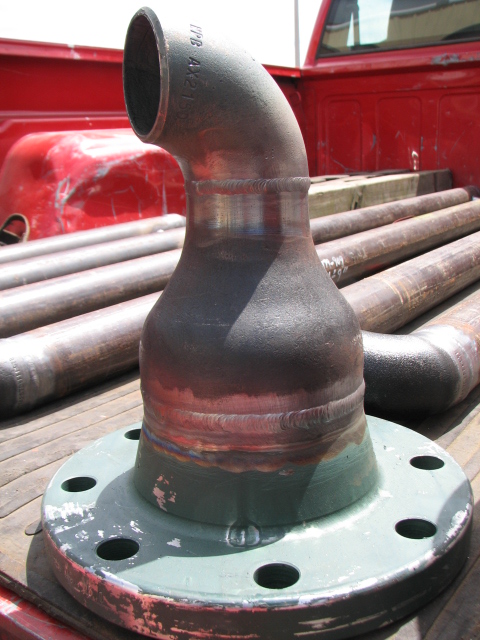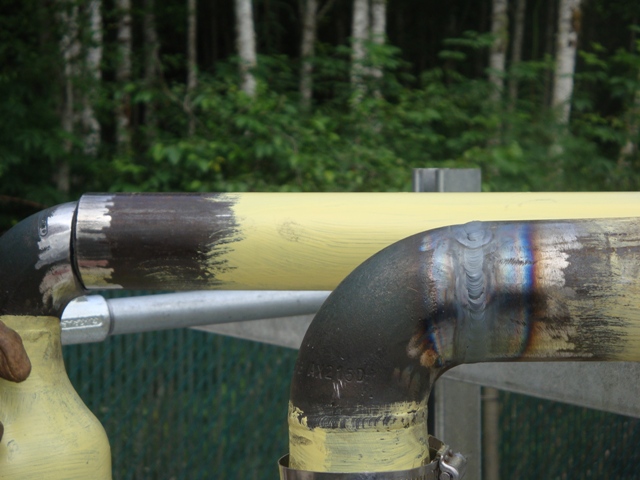Aaevald-
Thanks for the info and pictures. It looked like you were splitting the 90 ells on one of those photos to do what is referred to as "clamshell"? Seems to be a common solution and what we are leaning toward. I went to the pipe fitting supply store and lined up some short/long radius 90s to look at radii alignment and the contractor sent over a sketch of what he wants done and it looks to be the way we will be going. Located a website that published it's shop drawings [reproducable] for jacketed piping and I had the radii backward- they use short radius 90s for the jacket pipe and long radius for the carrier pipe but in this situation at least, the configurations on the runs, simple riser to 90 to horizontal run to 90 to another horizontal run, the 3rd carrier 90 is going to have to field fit in position after sliding the jacketing pipe over the middle horizontal weld which makes squaring and leveling a bit more of a PITA. With the carrier pipe jacketed there won't be any good way to square/level the fitting and it going to be closer to stovepiping the final fit than I like. Can't stand having to cut a tack. The jacketed 90s will have to be welded in after the carrier pipe is welded out and done in position. It's all good though [how 2002 that sounds], just going to increase the price on the job some. Think the count is abut 47 welds total including the split 90s, plus build some kind of support rack and get everything installed. A lot of times I just do the work for these guys hourly when they can't/won't supply a dimensioned diagram [which is often] and they need me to do all the field measureing, which I prefer over trusting their mistakes, and maybe cap it with a not to exceed price. They grumble some, but quietly, and the owner knows I have to make a living too although he sometimes acts aghast. One thing working to my advantage is that most of the guys who work for themselves don't have a pipe fabrication/welding backround and stick to general fabrication/light structural/ornamental. I do a lot of that as well but my backround as a rig welder/pipefitter let's me do this kind of work succesfully on these small jobs without the expense of doing it as a primary function which would include heavy insurance costs, R stamping, code documentation, licensing and all the overhead expenses a mechanical outfit like JH Kelly or such incurs. Of course I wouldn't mind being in those shoes if I had the brains to wear them, but that just aint the case.
Hello again yojimbo, it sounds like you are going to be welding "all" of the piping components of your job? I was working with a couple of fellas who were screwing all of the fuel piping together and slipping on the various containment piping for me to fit and weld together as we went along. Yes, we did split the elbows that were used for the various connection points. I would "tack" the ells to the inside of a piece of angle iron and then carefully set them up in a horizontal band saw and saw them in half. Worked pretty well, also match-marked the pieces to allow for correct matching before welding them back together. Most of the time the split ells could be tacked together over the supply piping screwed ells before they were fitted to the various ends of sleeving pipe that needed to be welded together. Having the "reducers" on the ends actually allowed for enough play in the system to provide access for screwing the supply piping together rather readily. Welding the supply piping would certainly pose a bit more of a challenge I believe, yet it can still be done. As you mentioned though, don't cut yourself short on bid hours for this project. Good luck as you move forward and if you can please share the progress with some pictures and correspondence. Best regards, Allan
Allen,
Wow, fast response. Wasn't even finished with the other replies. Yeah. I was thinking about how I was going to split the 90s. Want to do them in the horizontal bandsaw at the shop but hadn't figured out a good clamping system yet, and don't know if the 6" jacket pipe 90 will fit in on my 7 X 12 bandsaw anyway. Need to give this more thought. The smaller 3 and 4inch 90s should be able to be made to work, possibly do them vertically. Yeah, I will be doing the work alone, there's usually a guy to buff the welds and such if I need it, but you waste so much time in short term training it isn't usually productive. The 4" carrier line with the 6" jacketing is going to be heavy enough to warrant a second set of hands to install but I'll just have the supe on the forklift and do the rigging myself. He tells me this is going to be done in about 3 weeks- early Feb in WA state is always my preferred choice for outside field fabrication- but I will prefab 90s and randoms and as much as I can in the shop. He mentioned it being a 2 day job, sort of like trying to get a fish to bite [here fishy, fishy] and I told him he was looking at 3 plus more likely, but like I said, they grumble some but not too loudly, and after a 7 year relationship with them they know I don't gouge and haven't screwed up on them yet. The job is on the North side of Seattle though and I'm down by Tacoma which as you know means travelling through the belly of the beast and incumbent traffic horror. I'll include a mobilization on the quote and use it for a 2 day motel stay rather than driving through that muck, which they won't like but it's a job cost that I won't absorb. Did you make the move to FLA or still in the NW?
I happened to notice that you were online and when I clicked on this thread I noticed your reply. Haven't made a move yet, the wife calmed down about some of the issues that she was upset over and her real estate work started clicking rather well so we're still in WA. Haven't posted on here much either, my teaching job has been keeping me hopping in good ways. We qualified for some special funding that was offered up by the legislature and ended up with $250,000 to put into the welding program at our school. When I get a chance later I will be sharing a lot of this on the forum, both written and pictorial.
You are definitely working with some larger sleeving pipe and fuel line than the little project that I included here. I believe your saw will handle the 3" and 4" ells, but those 6" ones would probably not fit unless you were able to orient the ends of the inside radius flat onto the bed of the saw and somehow hold it upright and clamp the upper radius ends between the stops of the saw. If you end up thermal cutting them you may wish to consider how you can keep the dross from sticking to the opposite side of the cut on the inside of the ell. If you can somehow roll/bend a piece of flat bar to roughly the center line radius (1/4" or so thick by maybe 5 1/2" to 6" wide) to insert inside of the ell while you are cutting, it would likely provide a barrier to prevent what I was describing above. Look forward to a rundown on your progress. Good luck and best regards, Allan
Took me 2 hours from the south portal of the new Viaduct tunnel job to get to Tacoma yesterday, I hate driving the Seattle area.







